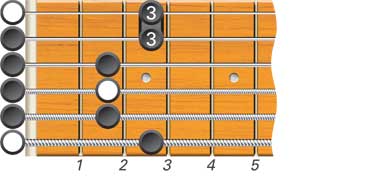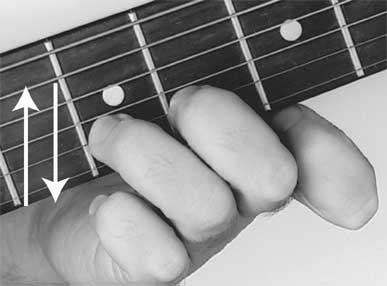
Advanced Lead Guitar Techniques
In this lesson you will be introduced to four commonly used Blues lead guitar techniques; the bend, the release bend, the double-note lick and vibrato. These techniques will prove to be more difficult than the previous techniques discussed and will require a great deal more practice to develop.
The Bend
The bend is achieved by bending a string with the left hand in the direction of the adjacent strings, causing the note to rise in pitch. This is done with the left hand finger which is fretting the note. This technique is demonstrated in the following example. In Example 57, the note on the third fret of the 2nd string is bent with the third finger of the left hand. In order to bend the note successfully, bend the string with the help of the second finger as well. This can be seen in the accompanying photograph. The symbol "B" and a curved line indicate a bend.


Play the note on the third fret of the 2nd string.

The third finger bends the string upwards, with the help of the second finger.
First try Example 58, a simple lick played in the key of E.

Now try Example 59, a similar lick to Example 58, but bends are added.

The Release Bend
The release bend is played by first bending the note indicated with the left hand, plucking the string while bent, then returning the string to its normal position. If played correctly the release bend creates a drop in pitch from a higher note to a lower note.
In order to play Example 60, bend the note on the 3rd string, second fret with the second finger of the left hand. Pluck the 3rd string with the right hand while the string is bent. Immediately after striking the string and still maintaining pressure on the note against the fretboard release the string carefully to its normal position. The release bend is indicated by a curved line and the symbol "R".


Bend the note on the second fret of the 3rd string.

After the note is played, release the string to its normal position.
First try Example 61, a simple lick in the key of E.

Now try Example 62, a similar lick to Example 61, but the release bend is used.

Double-Note Licks
Throughout all the previous licks in this book only one note was played at a time. The double-note lick is the playing of two notes simultaneously, usually within a lead guitar pattern. The most common double-note licks are highlighted in the following diagrams.






The double-note licks shown previously are also highlighted in the following example. Listen carefully to the accompanying recording to hear the correct sound of these licks.

Try the following example which incorporates double-note licks and a standard E shuffle.

Vibrato
This lesson introduces another popular lead guitar technique used frequently throughout a lick or solo, the vibrato. The vibrato is another technique controlled with the left hand finger which is fretting the note. This technique involves moving the string rapidly back and forth in the direction of the adjacent strings as the left hand finger is fretting the note.
In the following example vibrato is applied to the note on the fifth fret of the 2nd string. Listen carefully to this example on the recording to hear the correct effect of this technique. Vibrato is indicated by a wavy line above the note.


First try Example 66, a simple lick in the key of E.

Now try Example 67, the same lick as Example 66, but vibrato is used.

More Turnaround Licks
Some variations of the turnaround lick are shown here.

The next two turnarounds are in the key of A


The following examples make use of all the techniques discussed so far.








